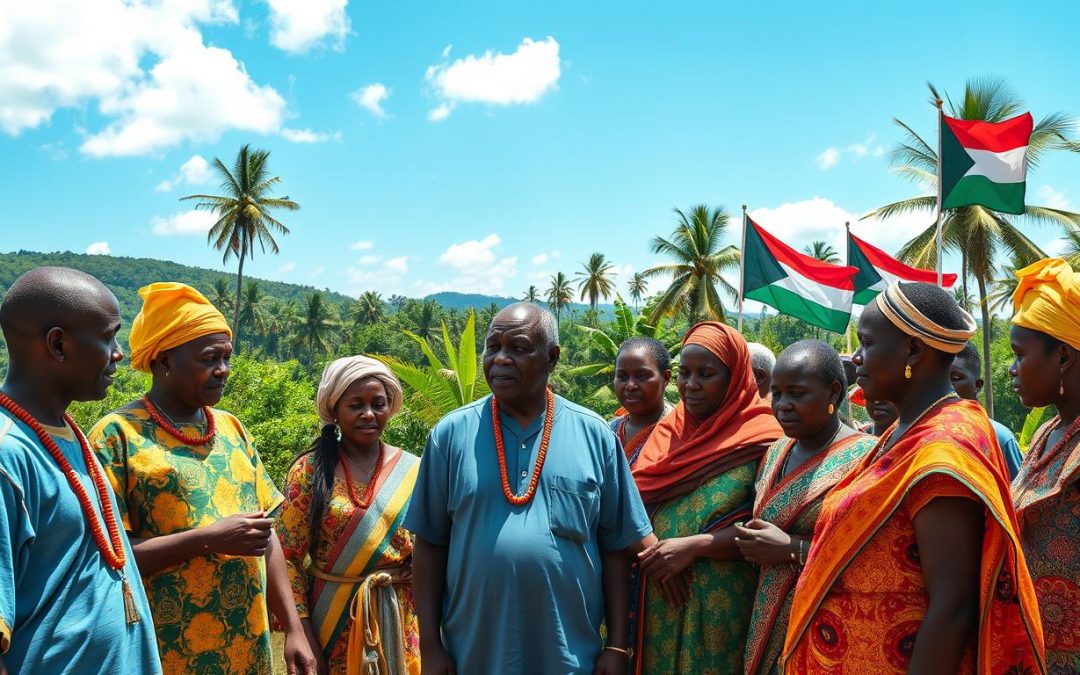Ever wondered how Gabon, a small Central African nation, handles its complex language scene? It’s a mix of French and indigenous tongues, creating a special way of talking.
In Gabon, language is a window into the country’s rich culture and history. French is the official tongue, used by 80% of people. But, indigenous languages like Fang are also key, with 32% of Gabonese speaking it at home.
Gabon’s language story is one of change and tradition. In Libreville, a third of the people speak French natively. Yet, in rural areas, people keep their ancient languages alive. This shows Gabon’s rich language diversity.
Key Takeaways
- French is the official language of Gabon, spoken by 80% of the population
- Fang is the most widely spoken indigenous language, with 32% native speakers
- Libreville has a significant native French-speaking population
- Gabon hosts approximately 40 different indigenous languages
- The country’s language landscape reflects a rich cultural heritage
The Linguistic Landscape of Gabon
Gabon’s languages show a rich cultural heritage. This comes from its history with indigenous languages. The mix of Bantu languages and French shows its colonial past and cultural growth.
Historical Development of Languages
About 2,000 years ago, Bantu languages came to Gabon. They split into around 40 different languages. This migration made Gabon’s language scene unique, shaping its culture.
- Bantu languages emerged around 2,000 years ago
- Approximately 40 different language patterns developed
- Linguistic diversity reflects complex cultural interactions
Current Language Distribution
Gabon’s language scene is complex. It has 62 speech patterns in 10 language units. This shows the country’s rich linguistic variety.
| Language Category | Number of Speakers | Percentage |
|---|---|---|
| French (Official) | Primary in Urban Areas | 100% Official Use |
| Bantu Languages | 40+ Indigenous Languages | Varies by Region |
| Foreign Languages | Spoken by Migrant Communities | 15.2% of Population |
Urban vs Rural Language Usage
In Gabon, city and countryside languages differ. In cities like Libreville, French is key for work and official talks. But, rural areas stick to Bantu languages, keeping cultural traditions alive.
“Language is the roadmap of a culture. It tells you where its people come from and where they are going.” – Rita Mae Brown
Gabon’s cities are home to 91.3% of its people. With over 85% literacy, its language scene is changing. It’s blending old ways with new global languages.
French as the Official Language of Gabon
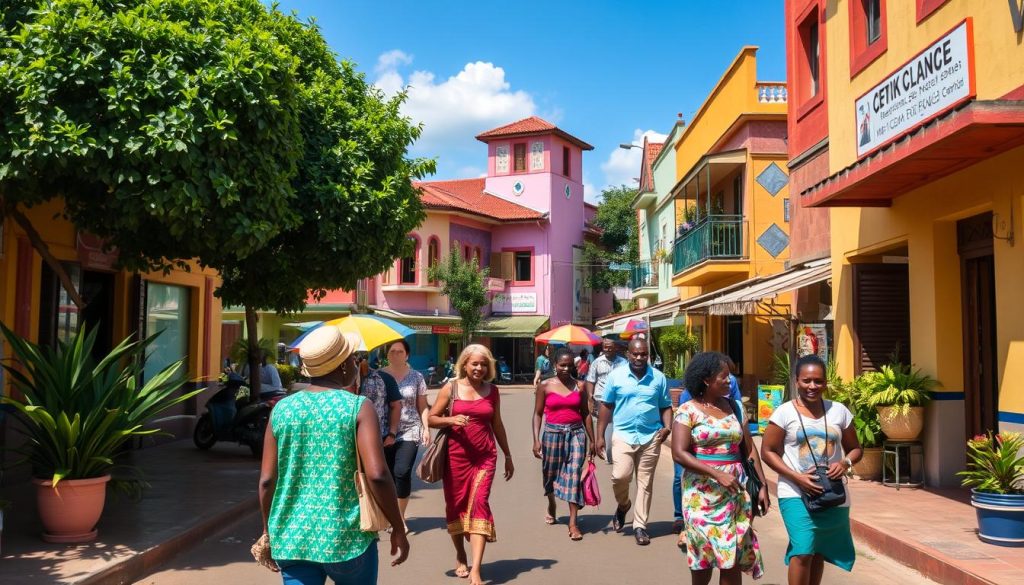
French is the official language of Gabon. It plays a big role in how people communicate, govern, and interact socially. Since the colonial era, French has deeply rooted itself in Gabonese culture.
Now, let’s dive into the interesting world of French in Gabon:
- Approximately 66.3% of Gabonese population speaks French
- 80% can communicate competently in French
- Native French speakers number around 320,000
The use of French changes from one region to another. In Libreville, the capital, about one-third of the people speak French natively. This widespread use of French comes from Gabon’s colonial past and its ongoing relationship with France.
| Language Metric | Percentage |
|---|---|
| Population Speaking French | 66.3% |
| Population Competent in French | 80% |
| Native French Speakers | 320,000 |
“French is not just a language in Gabon, it’s a bridge connecting diverse communities and facilitating national communication.”
The importance of French in Gabon shows the country’s history. It’s key in education, business, and government. Even though local languages are also valued, French is the main language for official talks.
The Rise of French Education and Literacy
French education in Gabon saw a big change in the 20th century. Before World War II, only a few Gabonese people could read French. Mostly, government and business workers used French.
After World War II, things changed a lot. France worked hard to make education better in its colonies. This effort greatly changed how people spoke in Gabon.
Educational Milestones
- 1960-1961 Census revealed critical language statistics:
- 47% of Gabonese over 14 spoke some French
- 13% were literate in the language
- By the 1990s, literacy rates soared to approximately 60%
- French became the primary medium of instruction in schools
Literacy Development Trajectory
More French education changed Gabon a lot. Schools helped people learn French, opening doors to better jobs and education. Students got to learn new things in French.
“Education is the most powerful weapon which you can use to change the world.” – Nelson Mandela
Today, literacy shows how successful these efforts were. French went from a colonial language to a key tool for growth in Gabon.
Fang: The Most Widely Spoken Indigenous Language
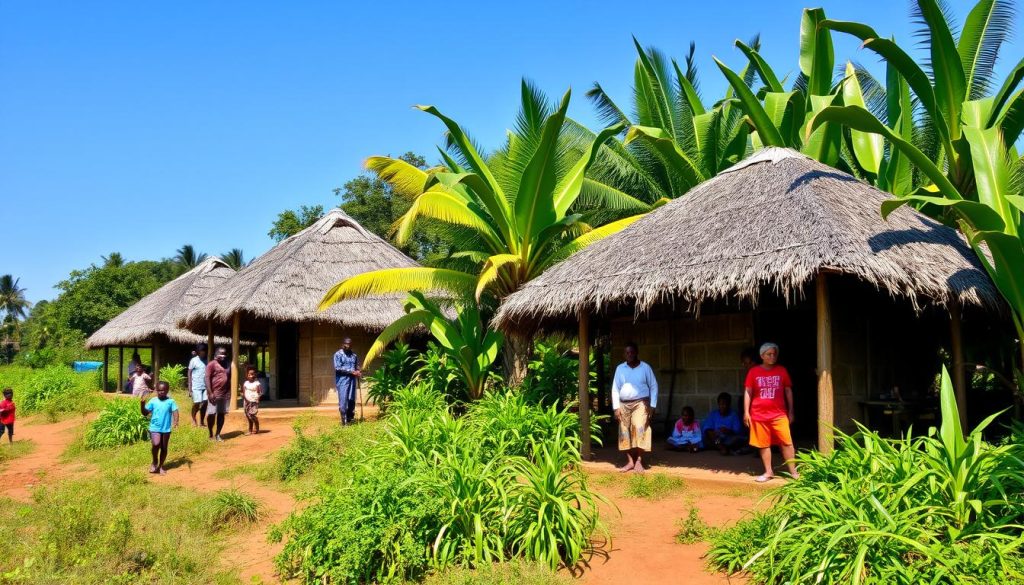
In Gabon, the Fang language is a key part of the culture. It connects people all over the country. Fang is more than just a way to talk; it’s a symbol of culture and history.
Explore Fang, a language that touches about 80% of Gabon’s people. With 2.3 million people in Gabon, around 1.84 million speak Fang. It’s a powerful language for many.
- Approximately 25% of Gabon’s ethnic groups speak Fang
- Over 90% of rural populations use Fang as their primary language
- Recognized alongside French as a significant national language
Fang is not just in Gabon. It’s also spoken in Equatorial Guinea and Cameroon. Its roots connect communities, creating a shared cultural experience that goes beyond borders.
“Fang is not just a language, it’s a living connection to our ancestral heritage and cultural identity.” – Gabonese Language Researcher
Even though French is used for government and school, Fang is still important. It’s especially vital in rural areas. Fang shows how important indigenous languages are for keeping cultures alive and communities together.
Other Major Indigenous Languages of Gabon
Gabon’s language scene is rich and varied, beyond French and Fang. The country has many indigenous languages. These languages show its cultural richness and deep history.
Explore Gabon’s language heritage. Here, Myene, Nzebi, Punu, and Omyene are key to keeping local cultures alive.
Language Demographics and Distribution
Gabon’s indigenous languages are very diverse. Some languages are doing well, but others need help to survive:
- Myene: Mainly spoken by the coast
- Nzebi: Found in central Gabon
- Punu: Common in the southwest
- Omyene: Spoken in the sea areas
Geographic Representation of Indigenous Languages
| Language | Primary Region | Estimated Speakers |
|---|---|---|
| Myene | Coastal Provinces | 5-7% of population |
| Nzebi | Central Gabon | 4-6% of population |
| Punu | Southwest | 3-5% of population |
| Omyene | Maritime Regions | 2-4% of population |
Social and Cultural Impact
These languages are more than just a way to talk. They hold cultural knowledge. Each language has its own stories, traditions, and history. These connect people to their past.
“Language is the roadmap of a culture. It tells you where its people come from and where they are going.” – Rita Mae Brown
Despite French’s wide use, these languages are crucial. They help keep Gabon’s culture and family ties strong.
Indigenous Bantu Languages
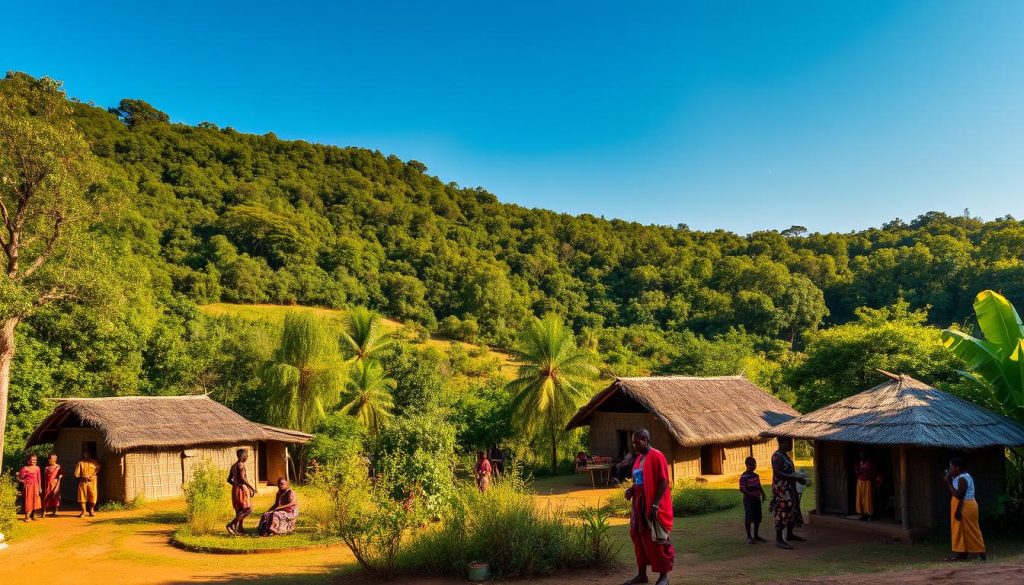
Gabon’s language scene is filled with indigenous Bantu languages. These languages are a key part of the country’s rich cultural heritage. They have been around for thousands of years.
The Bantu languages in Gabon are very diverse. Researchers think there are about 40 different languages spoken here. This shows the complex social and cultural history of the area.
- Estimated total Bantu languages: Between 440-680 distinct languages
- Bantu speakers worldwide: Approximately 350 million people
- Percentage of African population: Around 30%
Learning about these indigenous languages helps us understand Gabon’s cultural depth. Each language is a unique way of communicating, tied to local traditions and community identities.
“Language is the road map of a culture. It tells you where its people come from and where they are going.” – Rita Mae Brown
Linguists are still studying these Bantu languages. They document their grammar, vocabulary, and history. Their work is key to keeping these languages alive, as younger people often prefer French and modern ways of speaking.
The indigenous languages of Gabon are more than just ways to communicate. They hold cultural knowledge, traditional practices, and the collective memory of local communities.
Major Regional Languages: Mbere and Sira
Gabon’s language scene is rich and diverse. It plays a big role in keeping cultural heritage alive. Mbere and Sira are two key languages with deep roots in Gabonese society.
Cultural Significance
Mbere and Sira are more than just ways to talk. They are symbols of cultural identity and traditional knowledge. Each language holds unique stories, traditions, and history that link communities across Gabon.
- Mbere language represents approximately 25-30% of regional speakers
- Sira (Eshira) maintains strong cultural preservation traditions
- Both languages serve as critical vehicles for intergenerational knowledge transfer
Usage Patterns
Understanding Mbere and Sira shows their complex role. French is the main language for official talks. But, Mbere and Sira are still strong in local communities, especially in rural areas.
“Languages are the roadmaps of a culture. They tell you where its people come from and where they are going.” – Rita Mae Brown
Despite French and Fang’s influence, Mbere and Sira communities fight to keep their languages alive. They do this through family talks, traditional ceremonies, and community events.
- Rural communities maintain stronger language preservation
- Urban areas show gradual language shift towards French
- Educational initiatives support regional language conservation
Sign Language and Deaf Education
Sign language is key in deaf education in Gabon. It offers special ways for those with hearing loss to communicate. The start of American Sign Language (ASL) by deaf American missionary Andrew Foster was a big step forward.
Deaf education in Gabon has seen big strides, despite challenges. The world’s deaf population is estimated at 30 to 70 million. This shows how vital special education is.
“Communication is the key to understanding and inclusion for deaf individuals in Gabon”
- ASL was introduced to provide comprehensive communication methods
- Deaf communities in Gabon are developing unique sign language adaptations
- Limited resources continue to impact deaf education quality
The challenges for deaf education in Gabon include:
- Limited trained sign language instructors
- Insufficient educational infrastructure
- Social stigma surrounding hearing impairments
| Sign Language Indicator | Status in Gabon |
|---|---|
| Sign Language Recognition | Emerging |
| Deaf Education Access | Developing |
| Professional Sign Language Training | Limited |
Future plans aim to improve sign language access and deaf education. They also want to make environments more inclusive for those with hearing loss in Gabon. The work is ongoing to create better communication ways for the deaf community.
Language Preservation Efforts
Protecting indigenous languages is a key mission in Gabon. About 95% of the people belong to Bantu ethnic groups. The nation sees linguistic diversity as vital for keeping cultural heritage alive.
Government Initiatives
The Gabonese government has made big strides in language preservation. Since the 1970s, they’ve been documenting and studying Bantu languages. This approach aims to save these languages for future generations.
- Sponsored research on indigenous language documentation
- Developed linguistic mapping of regional languages
- Created archives of indigenous language materials
Community Programs
Local communities are key in saving languages. They’ve started projects to record oral traditions and make written materials in their languages.
“Language is the soul of a culture, and preserving it means preserving our identity.” – Gabonese Language Preservation Expert
| Language Preservation Strategy | Implementation Level |
|---|---|
| Oral Tradition Documentation | High |
| Community Language Workshops | Medium |
| Youth Language Programs | Developing |
Educational Support
Schools play a big role in saving languages. They teach indigenous languages alongside French. This helps young people keep their language heritage alive.
Despite global threats, Gabon is dedicated to saving its languages. Your support and awareness can help these unique languages survive.
Modern Language Trends and Foreign Influences
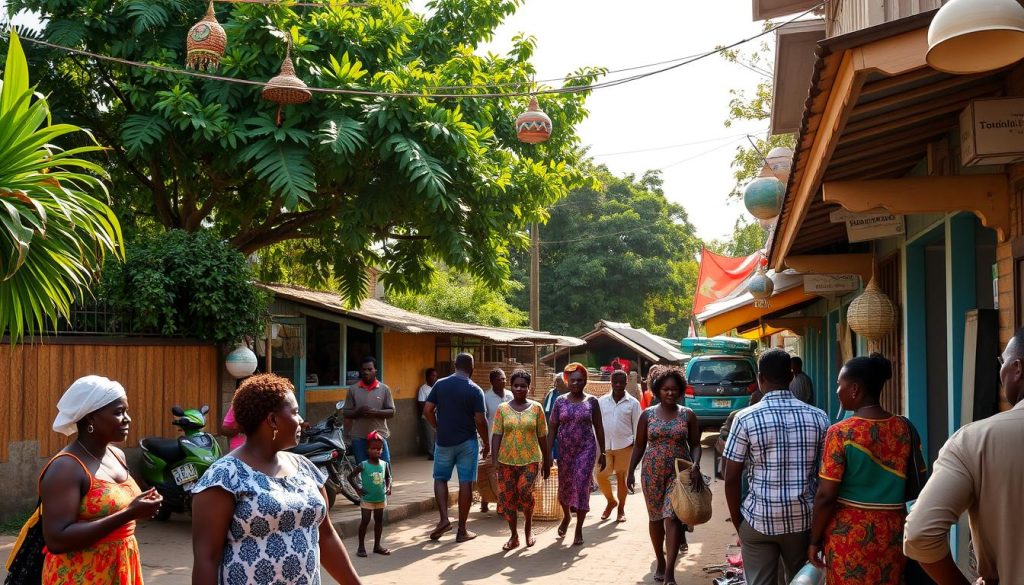
Gabon’s language scene is changing fast, thanks to global trends and government plans. President Ali Bongo is pushing for English as a key language for success. This marks a big change in how languages are used in Gabon.
More people want to learn English for several reasons:
- Global connections are growing
- There are more chances for work in international markets
- Education is opening up more
- Digital ways of talking are becoming popular
Even though English is gaining ground, local languages like Kikongo and Lingala are still very important. Cities show a lot of language variety, especially among the young. They are learning to use many languages.
“Language is the roadmap of a culture. It tells you where its people come from and where they are going.” – Rita Mae Brown
Language use is changing in interesting ways:
| Language | Urban Usage | Rural Usage |
|---|---|---|
| French | 85% | 65% |
| English | 25% | 10% |
| Indigenous Languages | 40% | 75% |
Digital tools are making language use more diverse. They offer new chances for languages to mix in Gabon’s communication world.
Conclusion
Gabon is a great example of how different languages come together. It has 43 languages, making its culture very rich. About 80% of people speak French, and 32% speak Fang.
This shows Gabon’s strong language skills. It shows how the country’s history and society have shaped its languages.
The languages of Gabon tell a story of survival and keeping traditions alive. They range from strong Bantu languages to French. Each language adds to Gabon’s cultural story.
Understanding Gabon’s languages helps us see their importance. They are more than just ways to talk. They hold cultural identity and memories.
Gabon faces a big challenge now. It needs to keep its languages diverse while staying united. With 26 strong languages and others growing, Gabon is at a turning point.
It’s important to protect Gabon’s indigenous languages and French. This will help keep its rich language heritage alive for the future.
The future of languages in Gabon looks bright. By valuing both French and local languages, Gabon can celebrate its diversity. This will help the country stay united.
Each language in Gabon opens a window to its rich culture. This makes Gabon a truly special place.
The above is subject to change.
Check back often to TRAVEL.COM for the latest travel tips and deals.
Here are some Tours & Sightseeing suggestions that might pique your interests!
